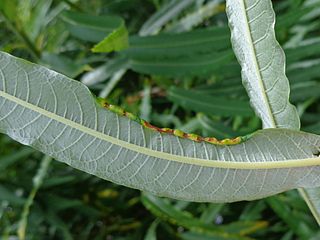
Salix caprea, known as goat willow, pussy willow or great sallow, is a common species of willow native to Europe and western and central Asia.

Rabdophaga rosaria is a gall midge which forms Camellia galls or terminal rosette gall on willow species. It was first described by Hermann Loew in 1850.
Rabdophaga clavifex is a gall midge which forms galls on the buds of willow species.

Dorytomus taeniatus is a species of weevil native to Europe. It was first described by Johann Christian Fabricius in 1781. The larvae cause a small growth on the catkins of willows.
Rabdophaga strobilina is a gall midge which forms galls on the buds of some species of willow. It was first described by Hermann Loew in 1850.
Rabdophaga iteobia is a gall midge which forms galls on the buds of willow species.
Rabdophaga jaapi is a species of gall midges which forms galls on creeping willow.

Rabdophaga rosariella is a species of gall midge which forms galls on sallows. It was first described by Jean-Jacques Kieffer in 1897.
Rabdophaga saliciperda is a species of gall midges which forms galls on willows. It was first described by Léon Jean Marie Dufour in 1841.

Rabdophaga salicis is a gall midge which forms galls on sallows. It was first described by Franz von Paula Schrank in 1803.
Rabdophaga albipennis is a gall midge which forms galls on the shoots of white willow.
Rabdophaga dubiosa is a gall midge which forms galls on the young shoots of willow.

Rabdophaga pierreana is a gall midge which forms galls on the young shoots of willow. It was first described by Jean-Jacques Kieffer in 1909.
Rabdophaga purpureaperda is a gall midge. The larvae tunnel in the shoots of purple willow and may cause the shoots to swell slightly. It was first described by Horace Francis Barnes in 1935.
Rabdophaga exsiccans is a gall midge. It was first described by Ewald Heinrich Rübsaamen in 1916. The larvae tunnel in the shoots of creeping willow and may cause the shoots to swell slightly.
Rabdophaga justini is a gall midge. It was first described by Horace Francis Barnes in 1935. The larvae tunnel in the shoots of purple willow.
Dasineura auritae is a gall midge which forms galls on the leaves of sallows and their hybrids. It was first described by Ewald Heinrich Rübsaamen in 1916.

Rabdophaga marginemtorquens is a gall midge which forms galls on willows and is found in Europe. It was described by Johann Jacob Bremi-Wolf in 1847.

Rabdophaga nervorum is a gall midge which forms galls on the leaves of sallows. It is found in Europe and was first described by the French entomologist, Jean-Jacques Kieffer in 1895.
Euura vesicator is a species of sawfly belonging to the family Tenthredinidae. The larvae feed internally in a gall on the leaves of purple willow and its hybrids. It was first described by Johann Jacob Bremi-Wolf in 1849.








